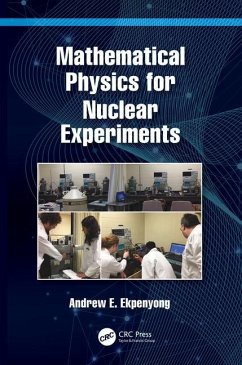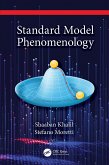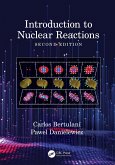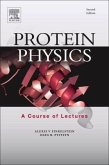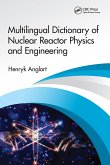Andrew E. Ekpenyong
Mathematical Physics for Nuclear Experiments
Andrew E. Ekpenyong
Mathematical Physics for Nuclear Experiments
- Gebundenes Buch
- Merkliste
- Auf die Merkliste
- Bewerten Bewerten
- Teilen
- Produkt teilen
- Produkterinnerung
- Produkterinnerung
Mathematical Physics for Nuclear Experiments presents an accessible introduction to the mathematical derivations of key equations used in describing and analysing results of typical nuclear physics experiments. Instead of merely showing results and citing texts, crucial equations in nuclear physics such as the Bohr's classical formula, Bethe's quantum mechanical formula for energy loss, Poisson, Gaussian and Maxwellian distributions for radioactive decay, and the Fermi function for beta spectrum analysis, among many more, are presented with the mathematical bases of their derivation and with…mehr
Andere Kunden interessierten sich auch für
![Mathematical Physics for Nuclear Experiments Mathematical Physics for Nuclear Experiments]() Andrew E. EkpenyongMathematical Physics for Nuclear Experiments55,99 €
Andrew E. EkpenyongMathematical Physics for Nuclear Experiments55,99 €![Standard Model Phenomenology Standard Model Phenomenology]() Shaaban KhalilStandard Model Phenomenology162,99 €
Shaaban KhalilStandard Model Phenomenology162,99 €![History of Original Ideas and Basic Discoveries in Particle Physics History of Original Ideas and Basic Discoveries in Particle Physics]() NewmanHistory of Original Ideas and Basic Discoveries in Particle Physics348,99 €
NewmanHistory of Original Ideas and Basic Discoveries in Particle Physics348,99 €![Introduction to Nuclear Reactions Introduction to Nuclear Reactions]() Carlos BertulaniIntroduction to Nuclear Reactions55,99 €
Carlos BertulaniIntroduction to Nuclear Reactions55,99 €![Protein Physics Protein Physics]() Alexei V. FinkelsteinProtein Physics80,99 €
Alexei V. FinkelsteinProtein Physics80,99 €![Multilingual Dictionary of Nuclear Reactor Physics and Engineering Multilingual Dictionary of Nuclear Reactor Physics and Engineering]() Henryk AnglartMultilingual Dictionary of Nuclear Reactor Physics and Engineering45,99 €
Henryk AnglartMultilingual Dictionary of Nuclear Reactor Physics and Engineering45,99 €![Protein Physics Protein Physics]() Alexei V. FinkelsteinProtein Physics60,99 €
Alexei V. FinkelsteinProtein Physics60,99 €-
-
-
Mathematical Physics for Nuclear Experiments presents an accessible introduction to the mathematical derivations of key equations used in describing and analysing results of typical nuclear physics experiments. Instead of merely showing results and citing texts, crucial equations in nuclear physics such as the Bohr's classical formula, Bethe's quantum mechanical formula for energy loss, Poisson, Gaussian and Maxwellian distributions for radioactive decay, and the Fermi function for beta spectrum analysis, among many more, are presented with the mathematical bases of their derivation and with their physical utility.
This approach provides readers with a greater connection between the theoretical and experimental sides of nuclear physics. The book also presents connections between well-established results and ongoing research. It also contains figures and tables showing results from the author's experiments and those of his students to demonstrate experimental outcomes.
This is a valuable guide for advanced undergraduates and early graduates studying nuclear instruments and methods, medical and health physics courses as well as experimental particle physics courses.
Key features
Contains over 500 equations connecting theory with experiments.Presents over 80 examples showing physical intuition and illustrating concepts.Includes 80 exercises, with solutions, showing applications in nuclear and medical physics.
This approach provides readers with a greater connection between the theoretical and experimental sides of nuclear physics. The book also presents connections between well-established results and ongoing research. It also contains figures and tables showing results from the author's experiments and those of his students to demonstrate experimental outcomes.
This is a valuable guide for advanced undergraduates and early graduates studying nuclear instruments and methods, medical and health physics courses as well as experimental particle physics courses.
Key features
Contains over 500 equations connecting theory with experiments.Presents over 80 examples showing physical intuition and illustrating concepts.Includes 80 exercises, with solutions, showing applications in nuclear and medical physics.
Produktdetails
- Produktdetails
- Verlag: CRC Press / Taylor & Francis
- Seitenzahl: 258
- Erscheinungstermin: 21. Januar 2022
- Englisch
- Abmessung: 234mm x 156mm x 18mm
- Gewicht: 530g
- ISBN-13: 9780367768522
- ISBN-10: 0367768526
- Artikelnr.: 62268036
- Verlag: CRC Press / Taylor & Francis
- Seitenzahl: 258
- Erscheinungstermin: 21. Januar 2022
- Englisch
- Abmessung: 234mm x 156mm x 18mm
- Gewicht: 530g
- ISBN-13: 9780367768522
- ISBN-10: 0367768526
- Artikelnr.: 62268036
Andrew Ekpenyong is a professor at Creighton University, USA. He earned his PhD in Physics from the University of Cambridge, UK, in 2012. He obtained a Master of Science degree in Physics in 2007 from Creighton University, Omaha, Nebraska, USA, where he teaches Nuclear Instruments and Methods, Quantum Mechanics, Physics of Radiation Therapy, Dosimetry and Radiation Protection, Biophysics as well as General Physics. He has supervised research and taught both graduates and undergraduates at Technical University, Dresden, Germany and Creighton University, USA. Dr Ekpenyong has authored/co-authored several articles in peer-reviewed journals in physics and medical physics. His research has ranged from the physics of cancer (a new frontier bordering on the mechanical properties of cancer cells and their role in cancer disease and metastasis) to the physics of radiation therapy.
Preface
About the Author
Acknowledgements
Symbols
Radioactivity and Decay Law
1.1 THE RADIOACTIVE DECAY LAW
1.1.0.1 Solution
1.1.0.2 Solution
1.1.0.3 Solution
1.2 RADIOACTIVE DECAY CHAIN
1.2.1 The Bateman Equations
1.2.1.1 The System of Differential Equations
1.2.1.2 Laplace Transformations
1.2.1.3 Inverse Laplace Transformations or Partial Fractions
1.2.1.4 Solution
1.3 TRANSIENT AND SECULAR EQUILIBRIUM
1.3.0.1 Solution
1.3.0.2 Solution
1.3.1 Transient Equilibrium Applications
1.3.1.1 Solution
1.3.2 Matrix Exponential and Other Methods for Bateman Equations
1.4 RADIOACTIVE DECAY ENERGY CALCULATIONS
1.4.0.1 Solution
1.4.0.2 Solution
1.5 MATHEMATICAL ELEMENTS OF ALPHA DECAY
1.5.1 Basics of Alpha Decay
1.5.1.1 Solution
1.5.1.2 Solution
1.5.1.3 Solution
1.5.2 Geiger-Nuttall Law
1.6 MATHEMATICAL ASPECTS OF BETA DECAY
1.6.1 Beta Decay Equations and Spectra
1.6.1.1 Solution
1.6.1.2 Solution
1.6.2 Continuous beta spectrum and neutrinos
1.6.3 Transition rate and Fermi-Kurie Plots
1.7 MATHEMATICAL PHYSICS OF GAMMA DECAY
1.7.1 Isomeric Transition Energetics and Multipole Selection Rules
1.7.1.1 Solution
1.7.2 Internal Conversion Coefficients
1.7.2.1 Solution
1.7.3 Electron Capture versus Isomeric Transition
1.7.4 Auger Electrons
1.7.4.1 Solution
1.7.5 Coincidences and Angular Correlations
1.7.5.1 Solution
1.8 SPONTANEOUS FISSION
1.9 ANSWERS
Probability and Statistics for Nuclear Experimental Data
2.1 PROBABILITY DISTRIBUTIONS AND THEIR CHARACTERISTICS
2.1.1 Cumulative Distribution
2.1.2 Expectation Values, Mean, Variance and Covariance
2.1.2.1 Solution
2.1.2.2 Solution
2.2 BINOMIAL DISTRIBUTION
2.2.0.1 Solution
2.2.0.2 Solution
2.2.0.3 Solution
2.3 POISSON DISTRIBUTION
2.3.0.1 Solution
2.3.0.2 Solution
2.3.0.3 Solution
2.3.0.4 Solution
2.3.0.5 Solution
2.4 GAUSSIAN OR NORMAL DISTRIBUTION
2.4.0.1 Solution
2.4.0.2 Solution
2.4.0.3 Solution
2.5 MAXWELLIAN DISTRIBUTION
2.6 CHI SQUARE DISTRIBUTION
2.6.0.1 Solution
2.7 EXPONENTIAL DISTRIBUTION
2.8 LANDAU AND OTHER DISTRIBUTIONS
2.9 DETERMINATION AND TESTS OF PROBABILITY DISTRIBUTIONS
2.9.1 Estimation of Mean, Variance and Covariance from Samples
2.9.2 Using Relative Frequency for Sample Mean and Variance
2.9.2.1 Solution
2.9.3 Chi-Square Test and other Statistical Tests on Experimental Data
2.10 UNCERTAINTIES: CALCULATION AND EXPRESSION
2.10.1 Accuracy and Precision, Error and Uncertainty
2.10.2 Statistical and Systematic Uncertainties
2.10.2.1 Statistical or Random Uncertainties
2.10.2.2 Systematic Uncertainties
2.10.3 Calculation, Estimation and Expression of Uncertainties
2.11 ERROR PROPAGATION
2.11.1 Error Propagation Formula
2.11.2 Examples of Error Propagation
2.11.2.1 Solution
2.11.2.2 Solution
2.11.2.3 Solution
2.12 ANSWERS
Energy Loss of Heavy Charged Particles through Matter
3.1 GENERAL RESULTS AND PERTURBATION THEORY
3.1.0.1 Solution
3.2 BOHR'S CLASSICAL FORMULA
3.2.1 Terminology and Physical Basis
3.2.2 Classical Derivation
3.2.2.1 Solution
3.3 BETHE'S QUANTUM MECHANICAL FORMULA
3.3.1 Derivation of Differential Cross Section
3.3.2 Validity Conditions and Relativistic Corrections
3.3.2.1 Solution
3.4 BLOCH AND OTHER EXTENSIONS OF BETHE'S FORMULA
3.4.1 Summary of Corrections and Extensions
3.4.2 Bloch's Correction and Extensions: Mathematical
3.4.2.1 Solution
3.4.2.2 Solution
3.4.2.3 Solution
3.4.2.4 Solution
3.4.2.5 Solution
3.5 RANGE OF HEAVY CHARGED PARTICLES
3.5.0.1 Solution
3.5.0.2 Solution
3.6 MEDICAL APPLICATIONS OF BRAGG PEAK
3.7 IDENTIFICATION OF PARTICLES AND OTHER APPLICATIONS
3.7.0.1 Solution
3.7.0.2 Solution
3.7.0.3 Solution
3.8 PSTAR, ASTAR AND OTHER SOFTWARE PACKAGES 1
3.9 RADIATIVE LOSS VIA BREMSSTRAHLUNG FOR HEAVY
CHARGED PARTICLES
3.10 ANSWERS
Energy Loss of Electrons and Positrons through Matter
4.1 COLLISIONAL LOSS AND MODIFIED BETHE FORMULA
4.1.0.1 Solution
4.1.0.2 Solution
4.1.0.3 Solution
4.2 RADIATIVE LOSS VIA BREMSSTRAHLUNG FOR LIGHT CHARGED PARTICLES
4.2.0.1 Solution
4.2.0.2 Solution
4.2.0.3 Solution
4.3 RANGE OF LIGHT CHARGED PARTICLES
4.3.0.1 Solution
4.3.0.2 Solution
4.3.1 Radiation Yield
4.4 ESTAR AND OTHER SOFTWARE PACKAGES
4.4.0.1 Solution
4.5 MULTIPLE COULOMB SCATTERING AND GAUSSIAN APPROXIMATIONS
4.6 TAMM-FRANK-CERENKOV RADIATION FORMULA
4.6.0.1 Solution
4.6.0.2 Solution
4.7 TRANSITION RADIATION
4.8 ANSWERS
Interactions of Photons in Matter
5.1 PHOTON ATTENUATION AND THE EXPONENTIAL FUNCTION
5.1.0.1 Solution
5.1.0.2 Solution
5.1.0.3 Solution
5.1.0.4 Solution
5.1.0.5 Solution
5.2 PHOTOELECTRIC CROSS-SECTION AND BORN APPROXIMATION
5.2.1 Photoelectric Effect
5.2.1.1 Solution
5.2.1.2 Solution
5.2.1.3 Solution
5.2.2 Photoelectric Cross Section from Perturbation Theory
5.2.2.1 Initial and Final States
5.2.2.2 Interaction and Result
5.2.2.3 Solution
5.2.2.4 Solution
5.2.2.5 Solution
5.2.2.6 Solution
5.2.2.7 Solution
5.3 KLEIN-NISHINA FORMULA FOR COMPTON SCATTERING
5.3.1 Compton Scattering
5.3.1.1 Solution
5.3.1.2 Solution
5.3.1.3 Solution
5.3.1.4 Solution
5.3.2 Derivation of the Klein-Nishina formula
5.4 THOMSON AND RAYLEIGH SCATTERING
5.4.0.1 Solution
5.4.0.2 Solution
5.5 PAIR PRODUCTION AND BORN APPROXIMATION
5.5.1 Kinematics of Pair/Triplet Production
5.5.1.1 Solution
5.5.1.2 Solution
5.5.2 Differential Cross Section for Pair Production
5.6 ANSWERS
General Mathematical Definitions and Derivations
A.1 CROSS SECTIONS
A.1.1 Scattering and Absorption Cross Sections
A.1.2 Differential Cross Sections
A.1.3 Total Cross Sections
A.2 SCHRÖDINGER'S EQUATION AND CROSS SECTIONS
A.3 BORN APPROXIMATIONS
A.3.1 Perturbation Theory
A.3.2 First Born Approximation for Scattering Amplitude
A.3.3 Born Series using Green's Function
A.3.3.1 Zeroth Order Solution
A.3.3.2 First Order Solution
A.3.3.3 Second Order Solution
A.3.3.4 Nth Order Solution
Experimental Data: from Creighton University NIM Lab
B.1 DATA: CHAPTER 2
B.1.1 Data for Fig.2.6
Bibliography
About the Author
Acknowledgements
Symbols
Radioactivity and Decay Law
1.1 THE RADIOACTIVE DECAY LAW
1.1.0.1 Solution
1.1.0.2 Solution
1.1.0.3 Solution
1.2 RADIOACTIVE DECAY CHAIN
1.2.1 The Bateman Equations
1.2.1.1 The System of Differential Equations
1.2.1.2 Laplace Transformations
1.2.1.3 Inverse Laplace Transformations or Partial Fractions
1.2.1.4 Solution
1.3 TRANSIENT AND SECULAR EQUILIBRIUM
1.3.0.1 Solution
1.3.0.2 Solution
1.3.1 Transient Equilibrium Applications
1.3.1.1 Solution
1.3.2 Matrix Exponential and Other Methods for Bateman Equations
1.4 RADIOACTIVE DECAY ENERGY CALCULATIONS
1.4.0.1 Solution
1.4.0.2 Solution
1.5 MATHEMATICAL ELEMENTS OF ALPHA DECAY
1.5.1 Basics of Alpha Decay
1.5.1.1 Solution
1.5.1.2 Solution
1.5.1.3 Solution
1.5.2 Geiger-Nuttall Law
1.6 MATHEMATICAL ASPECTS OF BETA DECAY
1.6.1 Beta Decay Equations and Spectra
1.6.1.1 Solution
1.6.1.2 Solution
1.6.2 Continuous beta spectrum and neutrinos
1.6.3 Transition rate and Fermi-Kurie Plots
1.7 MATHEMATICAL PHYSICS OF GAMMA DECAY
1.7.1 Isomeric Transition Energetics and Multipole Selection Rules
1.7.1.1 Solution
1.7.2 Internal Conversion Coefficients
1.7.2.1 Solution
1.7.3 Electron Capture versus Isomeric Transition
1.7.4 Auger Electrons
1.7.4.1 Solution
1.7.5 Coincidences and Angular Correlations
1.7.5.1 Solution
1.8 SPONTANEOUS FISSION
1.9 ANSWERS
Probability and Statistics for Nuclear Experimental Data
2.1 PROBABILITY DISTRIBUTIONS AND THEIR CHARACTERISTICS
2.1.1 Cumulative Distribution
2.1.2 Expectation Values, Mean, Variance and Covariance
2.1.2.1 Solution
2.1.2.2 Solution
2.2 BINOMIAL DISTRIBUTION
2.2.0.1 Solution
2.2.0.2 Solution
2.2.0.3 Solution
2.3 POISSON DISTRIBUTION
2.3.0.1 Solution
2.3.0.2 Solution
2.3.0.3 Solution
2.3.0.4 Solution
2.3.0.5 Solution
2.4 GAUSSIAN OR NORMAL DISTRIBUTION
2.4.0.1 Solution
2.4.0.2 Solution
2.4.0.3 Solution
2.5 MAXWELLIAN DISTRIBUTION
2.6 CHI SQUARE DISTRIBUTION
2.6.0.1 Solution
2.7 EXPONENTIAL DISTRIBUTION
2.8 LANDAU AND OTHER DISTRIBUTIONS
2.9 DETERMINATION AND TESTS OF PROBABILITY DISTRIBUTIONS
2.9.1 Estimation of Mean, Variance and Covariance from Samples
2.9.2 Using Relative Frequency for Sample Mean and Variance
2.9.2.1 Solution
2.9.3 Chi-Square Test and other Statistical Tests on Experimental Data
2.10 UNCERTAINTIES: CALCULATION AND EXPRESSION
2.10.1 Accuracy and Precision, Error and Uncertainty
2.10.2 Statistical and Systematic Uncertainties
2.10.2.1 Statistical or Random Uncertainties
2.10.2.2 Systematic Uncertainties
2.10.3 Calculation, Estimation and Expression of Uncertainties
2.11 ERROR PROPAGATION
2.11.1 Error Propagation Formula
2.11.2 Examples of Error Propagation
2.11.2.1 Solution
2.11.2.2 Solution
2.11.2.3 Solution
2.12 ANSWERS
Energy Loss of Heavy Charged Particles through Matter
3.1 GENERAL RESULTS AND PERTURBATION THEORY
3.1.0.1 Solution
3.2 BOHR'S CLASSICAL FORMULA
3.2.1 Terminology and Physical Basis
3.2.2 Classical Derivation
3.2.2.1 Solution
3.3 BETHE'S QUANTUM MECHANICAL FORMULA
3.3.1 Derivation of Differential Cross Section
3.3.2 Validity Conditions and Relativistic Corrections
3.3.2.1 Solution
3.4 BLOCH AND OTHER EXTENSIONS OF BETHE'S FORMULA
3.4.1 Summary of Corrections and Extensions
3.4.2 Bloch's Correction and Extensions: Mathematical
3.4.2.1 Solution
3.4.2.2 Solution
3.4.2.3 Solution
3.4.2.4 Solution
3.4.2.5 Solution
3.5 RANGE OF HEAVY CHARGED PARTICLES
3.5.0.1 Solution
3.5.0.2 Solution
3.6 MEDICAL APPLICATIONS OF BRAGG PEAK
3.7 IDENTIFICATION OF PARTICLES AND OTHER APPLICATIONS
3.7.0.1 Solution
3.7.0.2 Solution
3.7.0.3 Solution
3.8 PSTAR, ASTAR AND OTHER SOFTWARE PACKAGES 1
3.9 RADIATIVE LOSS VIA BREMSSTRAHLUNG FOR HEAVY
CHARGED PARTICLES
3.10 ANSWERS
Energy Loss of Electrons and Positrons through Matter
4.1 COLLISIONAL LOSS AND MODIFIED BETHE FORMULA
4.1.0.1 Solution
4.1.0.2 Solution
4.1.0.3 Solution
4.2 RADIATIVE LOSS VIA BREMSSTRAHLUNG FOR LIGHT CHARGED PARTICLES
4.2.0.1 Solution
4.2.0.2 Solution
4.2.0.3 Solution
4.3 RANGE OF LIGHT CHARGED PARTICLES
4.3.0.1 Solution
4.3.0.2 Solution
4.3.1 Radiation Yield
4.4 ESTAR AND OTHER SOFTWARE PACKAGES
4.4.0.1 Solution
4.5 MULTIPLE COULOMB SCATTERING AND GAUSSIAN APPROXIMATIONS
4.6 TAMM-FRANK-CERENKOV RADIATION FORMULA
4.6.0.1 Solution
4.6.0.2 Solution
4.7 TRANSITION RADIATION
4.8 ANSWERS
Interactions of Photons in Matter
5.1 PHOTON ATTENUATION AND THE EXPONENTIAL FUNCTION
5.1.0.1 Solution
5.1.0.2 Solution
5.1.0.3 Solution
5.1.0.4 Solution
5.1.0.5 Solution
5.2 PHOTOELECTRIC CROSS-SECTION AND BORN APPROXIMATION
5.2.1 Photoelectric Effect
5.2.1.1 Solution
5.2.1.2 Solution
5.2.1.3 Solution
5.2.2 Photoelectric Cross Section from Perturbation Theory
5.2.2.1 Initial and Final States
5.2.2.2 Interaction and Result
5.2.2.3 Solution
5.2.2.4 Solution
5.2.2.5 Solution
5.2.2.6 Solution
5.2.2.7 Solution
5.3 KLEIN-NISHINA FORMULA FOR COMPTON SCATTERING
5.3.1 Compton Scattering
5.3.1.1 Solution
5.3.1.2 Solution
5.3.1.3 Solution
5.3.1.4 Solution
5.3.2 Derivation of the Klein-Nishina formula
5.4 THOMSON AND RAYLEIGH SCATTERING
5.4.0.1 Solution
5.4.0.2 Solution
5.5 PAIR PRODUCTION AND BORN APPROXIMATION
5.5.1 Kinematics of Pair/Triplet Production
5.5.1.1 Solution
5.5.1.2 Solution
5.5.2 Differential Cross Section for Pair Production
5.6 ANSWERS
General Mathematical Definitions and Derivations
A.1 CROSS SECTIONS
A.1.1 Scattering and Absorption Cross Sections
A.1.2 Differential Cross Sections
A.1.3 Total Cross Sections
A.2 SCHRÖDINGER'S EQUATION AND CROSS SECTIONS
A.3 BORN APPROXIMATIONS
A.3.1 Perturbation Theory
A.3.2 First Born Approximation for Scattering Amplitude
A.3.3 Born Series using Green's Function
A.3.3.1 Zeroth Order Solution
A.3.3.2 First Order Solution
A.3.3.3 Second Order Solution
A.3.3.4 Nth Order Solution
Experimental Data: from Creighton University NIM Lab
B.1 DATA: CHAPTER 2
B.1.1 Data for Fig.2.6
Bibliography
Preface
About the Author
Acknowledgements
Symbols
Radioactivity and Decay Law
1.1 THE RADIOACTIVE DECAY LAW
1.1.0.1 Solution
1.1.0.2 Solution
1.1.0.3 Solution
1.2 RADIOACTIVE DECAY CHAIN
1.2.1 The Bateman Equations
1.2.1.1 The System of Differential Equations
1.2.1.2 Laplace Transformations
1.2.1.3 Inverse Laplace Transformations or Partial Fractions
1.2.1.4 Solution
1.3 TRANSIENT AND SECULAR EQUILIBRIUM
1.3.0.1 Solution
1.3.0.2 Solution
1.3.1 Transient Equilibrium Applications
1.3.1.1 Solution
1.3.2 Matrix Exponential and Other Methods for Bateman Equations
1.4 RADIOACTIVE DECAY ENERGY CALCULATIONS
1.4.0.1 Solution
1.4.0.2 Solution
1.5 MATHEMATICAL ELEMENTS OF ALPHA DECAY
1.5.1 Basics of Alpha Decay
1.5.1.1 Solution
1.5.1.2 Solution
1.5.1.3 Solution
1.5.2 Geiger-Nuttall Law
1.6 MATHEMATICAL ASPECTS OF BETA DECAY
1.6.1 Beta Decay Equations and Spectra
1.6.1.1 Solution
1.6.1.2 Solution
1.6.2 Continuous beta spectrum and neutrinos
1.6.3 Transition rate and Fermi-Kurie Plots
1.7 MATHEMATICAL PHYSICS OF GAMMA DECAY
1.7.1 Isomeric Transition Energetics and Multipole Selection Rules
1.7.1.1 Solution
1.7.2 Internal Conversion Coefficients
1.7.2.1 Solution
1.7.3 Electron Capture versus Isomeric Transition
1.7.4 Auger Electrons
1.7.4.1 Solution
1.7.5 Coincidences and Angular Correlations
1.7.5.1 Solution
1.8 SPONTANEOUS FISSION
1.9 ANSWERS
Probability and Statistics for Nuclear Experimental Data
2.1 PROBABILITY DISTRIBUTIONS AND THEIR CHARACTERISTICS
2.1.1 Cumulative Distribution
2.1.2 Expectation Values, Mean, Variance and Covariance
2.1.2.1 Solution
2.1.2.2 Solution
2.2 BINOMIAL DISTRIBUTION
2.2.0.1 Solution
2.2.0.2 Solution
2.2.0.3 Solution
2.3 POISSON DISTRIBUTION
2.3.0.1 Solution
2.3.0.2 Solution
2.3.0.3 Solution
2.3.0.4 Solution
2.3.0.5 Solution
2.4 GAUSSIAN OR NORMAL DISTRIBUTION
2.4.0.1 Solution
2.4.0.2 Solution
2.4.0.3 Solution
2.5 MAXWELLIAN DISTRIBUTION
2.6 CHI SQUARE DISTRIBUTION
2.6.0.1 Solution
2.7 EXPONENTIAL DISTRIBUTION
2.8 LANDAU AND OTHER DISTRIBUTIONS
2.9 DETERMINATION AND TESTS OF PROBABILITY DISTRIBUTIONS
2.9.1 Estimation of Mean, Variance and Covariance from Samples
2.9.2 Using Relative Frequency for Sample Mean and Variance
2.9.2.1 Solution
2.9.3 Chi-Square Test and other Statistical Tests on Experimental Data
2.10 UNCERTAINTIES: CALCULATION AND EXPRESSION
2.10.1 Accuracy and Precision, Error and Uncertainty
2.10.2 Statistical and Systematic Uncertainties
2.10.2.1 Statistical or Random Uncertainties
2.10.2.2 Systematic Uncertainties
2.10.3 Calculation, Estimation and Expression of Uncertainties
2.11 ERROR PROPAGATION
2.11.1 Error Propagation Formula
2.11.2 Examples of Error Propagation
2.11.2.1 Solution
2.11.2.2 Solution
2.11.2.3 Solution
2.12 ANSWERS
Energy Loss of Heavy Charged Particles through Matter
3.1 GENERAL RESULTS AND PERTURBATION THEORY
3.1.0.1 Solution
3.2 BOHR'S CLASSICAL FORMULA
3.2.1 Terminology and Physical Basis
3.2.2 Classical Derivation
3.2.2.1 Solution
3.3 BETHE'S QUANTUM MECHANICAL FORMULA
3.3.1 Derivation of Differential Cross Section
3.3.2 Validity Conditions and Relativistic Corrections
3.3.2.1 Solution
3.4 BLOCH AND OTHER EXTENSIONS OF BETHE'S FORMULA
3.4.1 Summary of Corrections and Extensions
3.4.2 Bloch's Correction and Extensions: Mathematical
3.4.2.1 Solution
3.4.2.2 Solution
3.4.2.3 Solution
3.4.2.4 Solution
3.4.2.5 Solution
3.5 RANGE OF HEAVY CHARGED PARTICLES
3.5.0.1 Solution
3.5.0.2 Solution
3.6 MEDICAL APPLICATIONS OF BRAGG PEAK
3.7 IDENTIFICATION OF PARTICLES AND OTHER APPLICATIONS
3.7.0.1 Solution
3.7.0.2 Solution
3.7.0.3 Solution
3.8 PSTAR, ASTAR AND OTHER SOFTWARE PACKAGES 1
3.9 RADIATIVE LOSS VIA BREMSSTRAHLUNG FOR HEAVY
CHARGED PARTICLES
3.10 ANSWERS
Energy Loss of Electrons and Positrons through Matter
4.1 COLLISIONAL LOSS AND MODIFIED BETHE FORMULA
4.1.0.1 Solution
4.1.0.2 Solution
4.1.0.3 Solution
4.2 RADIATIVE LOSS VIA BREMSSTRAHLUNG FOR LIGHT CHARGED PARTICLES
4.2.0.1 Solution
4.2.0.2 Solution
4.2.0.3 Solution
4.3 RANGE OF LIGHT CHARGED PARTICLES
4.3.0.1 Solution
4.3.0.2 Solution
4.3.1 Radiation Yield
4.4 ESTAR AND OTHER SOFTWARE PACKAGES
4.4.0.1 Solution
4.5 MULTIPLE COULOMB SCATTERING AND GAUSSIAN APPROXIMATIONS
4.6 TAMM-FRANK-CERENKOV RADIATION FORMULA
4.6.0.1 Solution
4.6.0.2 Solution
4.7 TRANSITION RADIATION
4.8 ANSWERS
Interactions of Photons in Matter
5.1 PHOTON ATTENUATION AND THE EXPONENTIAL FUNCTION
5.1.0.1 Solution
5.1.0.2 Solution
5.1.0.3 Solution
5.1.0.4 Solution
5.1.0.5 Solution
5.2 PHOTOELECTRIC CROSS-SECTION AND BORN APPROXIMATION
5.2.1 Photoelectric Effect
5.2.1.1 Solution
5.2.1.2 Solution
5.2.1.3 Solution
5.2.2 Photoelectric Cross Section from Perturbation Theory
5.2.2.1 Initial and Final States
5.2.2.2 Interaction and Result
5.2.2.3 Solution
5.2.2.4 Solution
5.2.2.5 Solution
5.2.2.6 Solution
5.2.2.7 Solution
5.3 KLEIN-NISHINA FORMULA FOR COMPTON SCATTERING
5.3.1 Compton Scattering
5.3.1.1 Solution
5.3.1.2 Solution
5.3.1.3 Solution
5.3.1.4 Solution
5.3.2 Derivation of the Klein-Nishina formula
5.4 THOMSON AND RAYLEIGH SCATTERING
5.4.0.1 Solution
5.4.0.2 Solution
5.5 PAIR PRODUCTION AND BORN APPROXIMATION
5.5.1 Kinematics of Pair/Triplet Production
5.5.1.1 Solution
5.5.1.2 Solution
5.5.2 Differential Cross Section for Pair Production
5.6 ANSWERS
General Mathematical Definitions and Derivations
A.1 CROSS SECTIONS
A.1.1 Scattering and Absorption Cross Sections
A.1.2 Differential Cross Sections
A.1.3 Total Cross Sections
A.2 SCHRÖDINGER'S EQUATION AND CROSS SECTIONS
A.3 BORN APPROXIMATIONS
A.3.1 Perturbation Theory
A.3.2 First Born Approximation for Scattering Amplitude
A.3.3 Born Series using Green's Function
A.3.3.1 Zeroth Order Solution
A.3.3.2 First Order Solution
A.3.3.3 Second Order Solution
A.3.3.4 Nth Order Solution
Experimental Data: from Creighton University NIM Lab
B.1 DATA: CHAPTER 2
B.1.1 Data for Fig.2.6
Bibliography
About the Author
Acknowledgements
Symbols
Radioactivity and Decay Law
1.1 THE RADIOACTIVE DECAY LAW
1.1.0.1 Solution
1.1.0.2 Solution
1.1.0.3 Solution
1.2 RADIOACTIVE DECAY CHAIN
1.2.1 The Bateman Equations
1.2.1.1 The System of Differential Equations
1.2.1.2 Laplace Transformations
1.2.1.3 Inverse Laplace Transformations or Partial Fractions
1.2.1.4 Solution
1.3 TRANSIENT AND SECULAR EQUILIBRIUM
1.3.0.1 Solution
1.3.0.2 Solution
1.3.1 Transient Equilibrium Applications
1.3.1.1 Solution
1.3.2 Matrix Exponential and Other Methods for Bateman Equations
1.4 RADIOACTIVE DECAY ENERGY CALCULATIONS
1.4.0.1 Solution
1.4.0.2 Solution
1.5 MATHEMATICAL ELEMENTS OF ALPHA DECAY
1.5.1 Basics of Alpha Decay
1.5.1.1 Solution
1.5.1.2 Solution
1.5.1.3 Solution
1.5.2 Geiger-Nuttall Law
1.6 MATHEMATICAL ASPECTS OF BETA DECAY
1.6.1 Beta Decay Equations and Spectra
1.6.1.1 Solution
1.6.1.2 Solution
1.6.2 Continuous beta spectrum and neutrinos
1.6.3 Transition rate and Fermi-Kurie Plots
1.7 MATHEMATICAL PHYSICS OF GAMMA DECAY
1.7.1 Isomeric Transition Energetics and Multipole Selection Rules
1.7.1.1 Solution
1.7.2 Internal Conversion Coefficients
1.7.2.1 Solution
1.7.3 Electron Capture versus Isomeric Transition
1.7.4 Auger Electrons
1.7.4.1 Solution
1.7.5 Coincidences and Angular Correlations
1.7.5.1 Solution
1.8 SPONTANEOUS FISSION
1.9 ANSWERS
Probability and Statistics for Nuclear Experimental Data
2.1 PROBABILITY DISTRIBUTIONS AND THEIR CHARACTERISTICS
2.1.1 Cumulative Distribution
2.1.2 Expectation Values, Mean, Variance and Covariance
2.1.2.1 Solution
2.1.2.2 Solution
2.2 BINOMIAL DISTRIBUTION
2.2.0.1 Solution
2.2.0.2 Solution
2.2.0.3 Solution
2.3 POISSON DISTRIBUTION
2.3.0.1 Solution
2.3.0.2 Solution
2.3.0.3 Solution
2.3.0.4 Solution
2.3.0.5 Solution
2.4 GAUSSIAN OR NORMAL DISTRIBUTION
2.4.0.1 Solution
2.4.0.2 Solution
2.4.0.3 Solution
2.5 MAXWELLIAN DISTRIBUTION
2.6 CHI SQUARE DISTRIBUTION
2.6.0.1 Solution
2.7 EXPONENTIAL DISTRIBUTION
2.8 LANDAU AND OTHER DISTRIBUTIONS
2.9 DETERMINATION AND TESTS OF PROBABILITY DISTRIBUTIONS
2.9.1 Estimation of Mean, Variance and Covariance from Samples
2.9.2 Using Relative Frequency for Sample Mean and Variance
2.9.2.1 Solution
2.9.3 Chi-Square Test and other Statistical Tests on Experimental Data
2.10 UNCERTAINTIES: CALCULATION AND EXPRESSION
2.10.1 Accuracy and Precision, Error and Uncertainty
2.10.2 Statistical and Systematic Uncertainties
2.10.2.1 Statistical or Random Uncertainties
2.10.2.2 Systematic Uncertainties
2.10.3 Calculation, Estimation and Expression of Uncertainties
2.11 ERROR PROPAGATION
2.11.1 Error Propagation Formula
2.11.2 Examples of Error Propagation
2.11.2.1 Solution
2.11.2.2 Solution
2.11.2.3 Solution
2.12 ANSWERS
Energy Loss of Heavy Charged Particles through Matter
3.1 GENERAL RESULTS AND PERTURBATION THEORY
3.1.0.1 Solution
3.2 BOHR'S CLASSICAL FORMULA
3.2.1 Terminology and Physical Basis
3.2.2 Classical Derivation
3.2.2.1 Solution
3.3 BETHE'S QUANTUM MECHANICAL FORMULA
3.3.1 Derivation of Differential Cross Section
3.3.2 Validity Conditions and Relativistic Corrections
3.3.2.1 Solution
3.4 BLOCH AND OTHER EXTENSIONS OF BETHE'S FORMULA
3.4.1 Summary of Corrections and Extensions
3.4.2 Bloch's Correction and Extensions: Mathematical
3.4.2.1 Solution
3.4.2.2 Solution
3.4.2.3 Solution
3.4.2.4 Solution
3.4.2.5 Solution
3.5 RANGE OF HEAVY CHARGED PARTICLES
3.5.0.1 Solution
3.5.0.2 Solution
3.6 MEDICAL APPLICATIONS OF BRAGG PEAK
3.7 IDENTIFICATION OF PARTICLES AND OTHER APPLICATIONS
3.7.0.1 Solution
3.7.0.2 Solution
3.7.0.3 Solution
3.8 PSTAR, ASTAR AND OTHER SOFTWARE PACKAGES 1
3.9 RADIATIVE LOSS VIA BREMSSTRAHLUNG FOR HEAVY
CHARGED PARTICLES
3.10 ANSWERS
Energy Loss of Electrons and Positrons through Matter
4.1 COLLISIONAL LOSS AND MODIFIED BETHE FORMULA
4.1.0.1 Solution
4.1.0.2 Solution
4.1.0.3 Solution
4.2 RADIATIVE LOSS VIA BREMSSTRAHLUNG FOR LIGHT CHARGED PARTICLES
4.2.0.1 Solution
4.2.0.2 Solution
4.2.0.3 Solution
4.3 RANGE OF LIGHT CHARGED PARTICLES
4.3.0.1 Solution
4.3.0.2 Solution
4.3.1 Radiation Yield
4.4 ESTAR AND OTHER SOFTWARE PACKAGES
4.4.0.1 Solution
4.5 MULTIPLE COULOMB SCATTERING AND GAUSSIAN APPROXIMATIONS
4.6 TAMM-FRANK-CERENKOV RADIATION FORMULA
4.6.0.1 Solution
4.6.0.2 Solution
4.7 TRANSITION RADIATION
4.8 ANSWERS
Interactions of Photons in Matter
5.1 PHOTON ATTENUATION AND THE EXPONENTIAL FUNCTION
5.1.0.1 Solution
5.1.0.2 Solution
5.1.0.3 Solution
5.1.0.4 Solution
5.1.0.5 Solution
5.2 PHOTOELECTRIC CROSS-SECTION AND BORN APPROXIMATION
5.2.1 Photoelectric Effect
5.2.1.1 Solution
5.2.1.2 Solution
5.2.1.3 Solution
5.2.2 Photoelectric Cross Section from Perturbation Theory
5.2.2.1 Initial and Final States
5.2.2.2 Interaction and Result
5.2.2.3 Solution
5.2.2.4 Solution
5.2.2.5 Solution
5.2.2.6 Solution
5.2.2.7 Solution
5.3 KLEIN-NISHINA FORMULA FOR COMPTON SCATTERING
5.3.1 Compton Scattering
5.3.1.1 Solution
5.3.1.2 Solution
5.3.1.3 Solution
5.3.1.4 Solution
5.3.2 Derivation of the Klein-Nishina formula
5.4 THOMSON AND RAYLEIGH SCATTERING
5.4.0.1 Solution
5.4.0.2 Solution
5.5 PAIR PRODUCTION AND BORN APPROXIMATION
5.5.1 Kinematics of Pair/Triplet Production
5.5.1.1 Solution
5.5.1.2 Solution
5.5.2 Differential Cross Section for Pair Production
5.6 ANSWERS
General Mathematical Definitions and Derivations
A.1 CROSS SECTIONS
A.1.1 Scattering and Absorption Cross Sections
A.1.2 Differential Cross Sections
A.1.3 Total Cross Sections
A.2 SCHRÖDINGER'S EQUATION AND CROSS SECTIONS
A.3 BORN APPROXIMATIONS
A.3.1 Perturbation Theory
A.3.2 First Born Approximation for Scattering Amplitude
A.3.3 Born Series using Green's Function
A.3.3.1 Zeroth Order Solution
A.3.3.2 First Order Solution
A.3.3.3 Second Order Solution
A.3.3.4 Nth Order Solution
Experimental Data: from Creighton University NIM Lab
B.1 DATA: CHAPTER 2
B.1.1 Data for Fig.2.6
Bibliography

